Tensions rose close to the boiling point early this summer amid a historic water shutoff in the Klamath Basin. Since then, irrigators in the Klamath Project have spent the growing season trying to make the most of a summer with no surface water from Upper Klamath Lake.
Jefferson Public Radio spoke with farmers leading up to the Klamath Water Users Association’s annual harvest tour last month. As the town of Merrill hosts the 84th annual Klamath Basin Potato Festival this weekend, JPR looked at the harvest for the Project’s driest year on record.
‘There’s very little fruit to show’
At the end of the summer, Ryan Kliewer, a third-generation farmer, is counting his losses.
Kliewer sits on a generator outside of an old dairy-turned-brewery on his brother’s farm in Midland, just outside of Klamath Falls. He’s holding a cold Pilsner he and his brother Ty made themselves. The brothers co-own Skyline Brewery. They opened it in 2018 as a way to supplement their uncertain farming income and as a way to decompress.
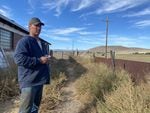
Midland farmer Ryan Kliewer is counting his losses after a summer with no surface water and concerns over how to keep long-standing customers.
Holly Dillemuth / JPR News
The Kliewer brothers had just hosted dozens of attendees to finish off the harvest tour that afternoon. The annual tour is an opportunity to showcase the agricultural diversity of the Klamath Basin and the bounty produced from the growing season. For Ryan Kliewer and many others, the tour this year was a chance to see innovative farming strategies up close, but more so to assess the damage.
“We usually use the fall harvest tour to showcase the food-to-table relationship so people can understand more about where their food comes from,” Kliewer said. “This year, in my case, there’s very little fruit to show.”
Kliewer said the amount of hay he was able to produce this year is just enough to feed his 25 cows this winter. Kliewer has had to tell long-time hay customers, he’s sorry but has no hay to sell them. In a competitive hay market, that hurts.
“If they go somewhere else for their product, they are likely to not return … We’re fracturing our sales relationships that we’ve had for decades.”
Kliewer said he’s dipping into his savings from last year just to survive.
How we got here
Kliewer isn’t alone.
As climate change increasingly makes its effects felt in the region, the Klamath Basin has experienced intensifying droughts in recent decades. This has led to demands on the water in the region often exceeding the supply, placing the needs of Klamath Basin farmers, endangered fish, and downstream tribes in conflict.
This year, due to extreme drought and declining populations of endangered Lost River and shortnose sucker fish in Upper Klamath Lake, the federal Bureau of Reclamation - which controls the Klamath Project -- cut off water to irrigators in order to keep lake levels sufficiently high for the fish to survive. The main supply canal that supplies water from Upper Klamath Lake to the Klamath Project remained closed this summer, and only a handful of irrigators got any surface water for their crops.
Some agriculture producers were able to use groundwater to partly make up for the loss of irrigation water from the lake. Others had little or no groundwater access. But for pretty much everyone, it’s been a hard season.
‘I don’t know of any crop in the valley that’s going to be what it should be’
Ben DuVal sat in a patio chair on his back porch in late August, looking out at the dry field adjacent to the farmhouse on the outskirts of Tulelake, near the Oregon-California border. He and his wife, Erika, farm 600 acres in Tulelake and Newell, California.
“We’re sitting on my grandfather’s original World War II homestead,” DuVal said. “After he got out of World War II, they were draining this part of the lake and developing this area. This area had never been farmed or settled before. It was divided up into homesteads and he was in the last drawing. In 1949, he was granted this homestead.”
The DuVals bought the house from his grandfather in 2003 and are the third generation to farm the land.
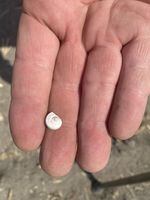
Ben DuVal holds a tiny shell from the soil of his farm, a reminder that the acreage was once lake bottom before it was drained in the early 20th Century to create agricultural land.
Holly Dillemuth / JPR News
As president of the Klamath Water Users Association, DuVal represents more than a dozen irrigation districts in the Klamath Reclamation Project. He says many farmers are using groundwater wells to try to compensate for the lack of surface water from the canals this summer. And, he says, they’re not happy about it, not least because electricity to run well pumps is expensive.
“None of us are pumping irrigation wells because we want to. It’s because it’s the only option that we have to keep our farms and our families here,” DuVal said.
Tulelake Irrigation District, DuVal’s district, is one of the only districts that has wells, though there are areas of the Project the wells can’t reach. That’s true with his property because he’s located on the outskirts of Tulelake close to Newell. Without surface water from Upper Klamath Lake or available groundwater, the field adjacent to DuVal’s family homestead is dry and dusty, instead of the usual lush, green hue.
DuVal walked out in the field, bending to pick up one of the white shells that can be seen in the soil, remnants of a time when all these fields were under the water of Tule Lake, before it was drained at the beginning of the 20th Century.
“That field’s growing nothing and you can’t pay mortgages with crops that aren’t growing,” DuVal said. “I don’t know of any crop in the valley that’s going to be what it should be.”
The alfalfa and wheat he was able to grow this summer are thanks to friends who donated their groundwater to his operation since he doesn’t have his own well.
“Some of my neighbors at times, they probably shorted their own crops because they were pumping water for me,” DuVal said. “There’s no way I could have made it through this year without neighbors helping me out.”
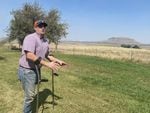
Ben DuVal in a field near his home in Tulelake.
Holly Dillemuth / JPR News
That kind of cooperation is more than just a silver lining on a year like this; it’s a way to hold on. While appreciative of the donated water and federal relief funding programs, DuVal acknowledged it’s not a long-term solution.
“It doesn’t cover the mortgage, taxes, and my irrigation assessment, which you have to pay even if you don’t get water,” he said.
DuVal said this year has been worse than the water shutoff in 2001, the last time federal water managers severely cut back on irrigation allotments to preserve water for endangered fish.
“To a degree, we’ve recovered since 2001 but this year is definitely taking us back to that place … The impacts of this are going to be long and far-reaching.”
‘All my friends that are farmers, we’re beat’
Scotty Fenters drives his pickup down a road next to one of his potato fields in Malin, on the California border, in mid-September. Fenters is a member of a potato packing shed in addition to farming his own operation.
Stepping out of the pickup, he knelt in the dirt and unearths a handful of reddish fingerling potatoes.

Midland farmer Ryan Kliewer is counting his losses after a summer with no surface water and concerns over how to keep long-standing customers.
Holly Dillemuth / JPR News
Fenters expected “mediocre” crops for his own personal operation, due to heat and smoke, and says he’ll be grateful to break even financially. He counts himself lucky for the yield he can produce after a year like this.
Fenters said that despite the lack of surface irrigation water, his operation has so far been able to farm 80% of what he normally would due to the use of groundwater wells.
Smoke from area wildfires and the continuing impact of the COVID-19 pandemic added to the hardships brought on by the drought. Fenters said this season’s hardships are pushing a lot of his neighbors to the breaking point.
“I can’t stress enough, if it happens again where we get a really dry winter, it will be a total wild card who survives the following year, if anybody,” he said. “You’re going to see some people decide, maybe this isn’t worth it.”

Scotty Fenters drives his pickup in Malin in September, as harvest is getting underway.
Holly Dillemuth / JPR News
All these stress factors mean that by the time harvest is completed, agricultural producers are exhausted.
THANKS TO OUR SPONSOR:
“All my friends that are farmers, we’re beat,” Fenters said.
‘We’re really draining our resources’
Dan Chin, owner of Chin Farms and Wong Potatoes in Merrill, is the grandson of the company’s founder, Sam Wong, who came to the United States from China more than a century ago.
Chin’s crops include grain, alfalfa, and potatoes.
This year, Chin said he’s farming about 40% of the acreage he would normally plant, with the other 60% dry and fallow due to lack of a surface water allocation this year. Chin was able to access groundwater to produce organic potatoes for Whole Foods, as well as reds, yellows, and organic potatoes for Walmart in California.

Dan Chin, a Merrill farmer, inspects his potato harvest.
Holly Dillemuth / JPR News
The impact of so many reductions doesn’t end with just him, Chin said.
“It not only hurts me but it hurts the seed grower, it hurts the fertilizer companies, ‘cause they’re not selling as much … and so they’re hurting, too. It’s not just the farmers, it’s the whole trickle-down effect.”
Wong Potatoes has sold to some customers in Sacramento since the company started 92 years ago.
“As far as the return, we’ll be able to take care of our customers,” Chin said.
“This year we’re going to survive because of the well water but we’re really draining our resources,” Chin said. “We were really worried about these well waters holding up for the year and we were lucky, all the ones that we used held up. But there’s other farmers in the area that their irrigation wells went down.”
Groundwater isn’t the answer
Ivan Gall agrees groundwater isn’t a sustainable solution for agriculture in the Basin. Gall is the field services division administrator at Oregon Water Resources Department. He said he’s concerned about groundwater getting depleted as use increases, especially with the hundreds of domestic wells that went dry this summer.
“There have been immediate impacts from this year’s groundwater use and that will persist in the next year and future years if significant amounts of groundwater continue to be used like this,” Gall said.
Gall described the aquifer system used to access groundwater as a bank account where deposits are made during the recharge part of the season, through rain, snowmelt, and leakage from streams and Upper Klamath Lake that can recharge that aquifer system.
When your withdrawals exceed deposits from the bank, it leads to persistent decline in the account balance, or in this case, the groundwater levels, Gall said.
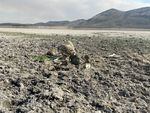
Spring Lake, a private body of water that uses water from Upper Klamath Lake, is usually full this time of year.
Holly Dillemuth / JPR News
“It’s certainly not an infinite resource that the Basin can depend upon in the long-term. That’s why it’s so important to look at long-term solutions where there’s some balance used with surface and groundwater to meet all of the needs of all of the water users in a sustainable fashion.”
Oregon Water Resources Department has documented declining groundwater wells in the Klamath Basin since 2001.
For most Project irrigators, the use of groundwater aquifers is a good “backup” supply during times of water shortage, Gall said, but it’s not intended as a primary resource.
“The Basin isn’t going to run out of groundwater resources next year, as an example, but every one of those years where they exceed the recharge, those groundwater levels will continue to decline,” Gall said.
Future of Basin farming is uncertain for some
Midland farmer Justin Grant has had his share of obstacles this summer, from his domestic well going dry in July to a reduction in his farm’s productivity going into next year.
With zero surface water allocated from Upper Klamath Lake, he pumped from his small irrigation well to keep at least some of his pastures green and his cows fed.
“We’re using and farming less than 40% of our acres this year due to the lack of water,” Grant said. “Instead of doing 30 acres of alfalfa, we should be doing more than 100 easily … We tried to be as sparing as we could with that just to kind of keep from drawing down the water table as much as possible, but still be able to produce some hay for our cattle, and put water in the ditch for them to drink.”
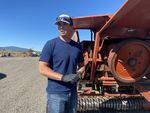
Justin Grant, a Midland farmer, says the impact on his crops of the water shutoff to most of the Klamath Project this summer has been huge.
Holly Dillemuth / JPR News
Grant said the little bit of grain hay he grew had a yield that was less than 20% of what it would have been, had he received a surface water allocation from Upper Klamath Lake, because the conditions were so dry to begin with.
The 32-year-old acknowledges it’s a terrible situation but is glad that some people have worked together to help one another.
“I think the worry is, are they going to be around next year and years to follow?” Grant said.
The answer to that question is something many farmers are grappling with as harvest season sets in.
“It’s partially difficult to have faith that the future is going to bring good things because it’s been such a daunting time for the last two decades,” Grant said.
Millions in federal relief
The silver lining in this grim picture is that the federal government is sending tens of millions of dollars to help Klamath Basin farmers deal with the losses of this dry season. The Bureau of Reclamation is providing the Basin with $25 million and the Department of Agriculture is providing an additional $15 million, to be administered via the Klamath Project Drought Response Agency by Dec. 31.
There is currently no state funding available for drought relief, according to OWRD officials.
Eligible agricultural producers can submit up to 5,000 acres per applicant, for $200 per acre, according to the application.
But while farmers say they’re glad to have the help, it doesn’t make them whole.
Kliewer said his farm qualifies for some federal relief, through the USDA but not through Reclamation’s program. His costs are fixed, so he still has to make the same payments to the bank.
“It’s a band-aid on essentially a hemorrhage,” Kliewer said. “If that was put out to save my bacon for the year, it is not going to.”
Fenters sees federal funding as extra money to help with expenses, but he doesn’t believe it’s going to be game-changing for farms.
“There’s going to be a lot of places operating on a loss this year. Just a matter of how big of a loss are they going to operate off of,” Fenters said.
Praying for rain
With uncertainty over water going forward, it makes planning ahead difficult for many farmers.
But even aside from planning, Kliewer said, in hindsight, he questions his career choice, even as he plans to farm again next year. He has a family to support and investments to maintain.
“As far as next year, the only thing we can do for this year is pray for rain, pray for a really good winter.”
Kliewer doesn’t mince words about the impact of water regulation over the years on farmers in the Project. He called it a “death by 1,000 cuts.”
“We’re getting to the point where we can barely crawl,” he said.
THANKS TO OUR SPONSOR:
"bitter" - Google News
October 23, 2021 at 08:03PM
https://ift.tt/3vDEp4N
Bitter Harvest: Klamath Basin farmers take stock of their losses - OPB News
"bitter" - Google News
https://ift.tt/3bZFysT
https://ift.tt/2KSpWvj
Bagikan Berita Ini















0 Response to "Bitter Harvest: Klamath Basin farmers take stock of their losses - OPB News"
Post a Comment